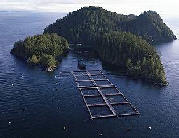|
EUROPEAN CETACEAN BYCATCH CAMPAIGN |
|
|
|
|
|
(Photo courtesy |
|
In a 12 page advisory letter, PFRCC chair John Fraser, a former federal minister of fisheries, explained that the Council’s primary concern is “to protect and provide safe passage for the 2002 pink salmon brood year on their seaward migration through the Broughton Archipelago." |
|
Pink salmon smolts infected with sea lice |
|
Environmentalists believe that massive outbreaks of sea lice in the commercial pens boosted local lice populations to plague levels. The sea lice |
|
Sea lice on salmon skin (Photo courtesy Alexandra Morton) |
|
The alarm was first sounded in 2001 when marine biologist Alexandra Morton, who lives on an island in the archipelago, noticed sea lice infesting juvenile pink salmon. She estimated that 78 percent of her 700 smolt sample were lethally infected, and warned the two levels of government of possible dire consequences. “The fish farms are providing a breeding ground for the lice,” Morton said. |
|
Fish farm in the Broughton Archipelago |
|
|



